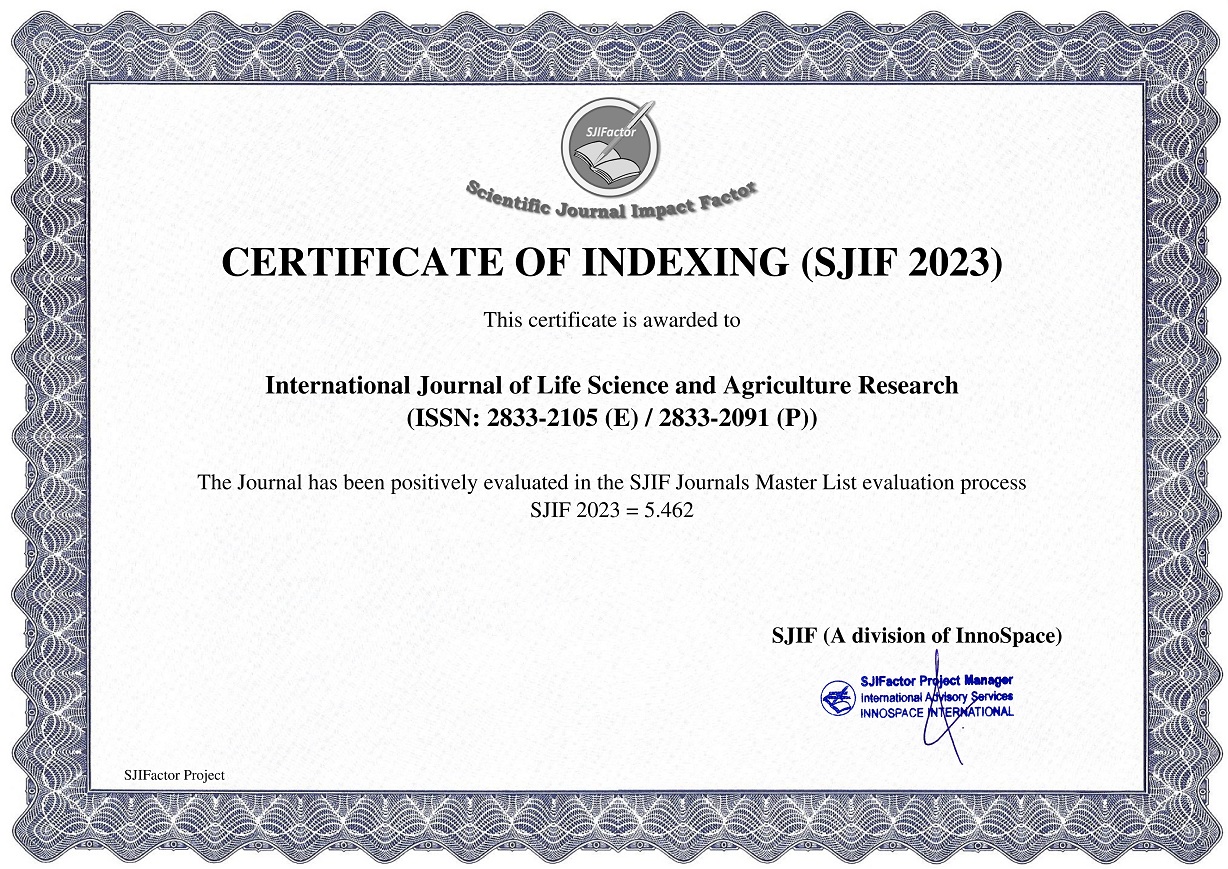Assessment of Climate Factors on Benthic Fauna in Jabi Lake Federal Capital Territory Abuja
DOI:
https://doi.org/10.55677/ijlsar/V03I3Y2024-10Keywords:
Meteorological and hydrochemical parameters, Benthic Fauna, CCAAbstract
Studies of climate factors on benthic fauna in Jabi Lake was conducted from November, 2016 to June, 2017 using combination of insitu and laboratory equipment. Three stations were selected to determine the climate characteristics based on activities in the various stations and proximity to terrestrial influence. The results of the climatic parameters showed that atmospheric temperature range 18.40 to 32.100C, rainfall from 1997-2016 range from 0.00 to 513.8mm, relative humidity range from 22.00 to 72.20%, wind speed range from 0.40 to 3.40m/s, variation with time in all the stations. There were significant differences (P<0.05) between these parameters, within the months, stations and seasons. A total of 1, 867 benthic fauna were collected and identified into 6 phyla, 27 families and 60 species. All the species identify were represented in all the stations. Faunistic composition and abundance of benthic fauna showed that Family Bithyniidae has the highest percentage composition 60% (1120) followed by Lymnaelidae and Nuculoidae with 4% each. Chironmidae has 3% while others has 2 to 1%. Similarity ratio computed by Jaccard’s similarities index (0.63) shows that the three stations has about 63% species similarities between them. The relationship between climatic variable and fauna in the CCA diagram shows only torant organisms on positive axis i.e. representative of Nematoda, Mollusca, Polifera and Annelida has affinity to variables while Crustacean and Arthropoda were senstive to environmental condition. The Shannon Weiner species diversity index is 0.96 which is quite high.
References
Adebisi, A. A. (1989) Planktonic and benthic organisms in some ponds on the Oluponna fish farm, Olupona, Oyo state, A Report Prepared for Agro Nigeria. Teem SR1, Ibadan, Nigeria.
Adebisi, A.A. (1989) The Physico-Chemical Hydrology of a Tropical Seasonal River Upper Ogun River. Hydrogia. 79159-165.
Alaku, S. O. (1991). Conservation and management of water resources in the semi-arid areas of northeastern Nigeria. In: Arid Zone Pages 179 – 196. Hydrology and Water Resources University of Maiduguri Press, Maiduguri.
Barness P. (1994). A new approach to protecting the environment: The European Union’s Environmental Management and Audit Regulation.
Bispo, PC., Oliveira, LG., Bini, LM. and Sousa, KG. 2006. Ephemeroptera, Plecoptera and Trichoptera assemblages from richness in mountain streams of Central Brazil: environmental factors influencing the distribution and abundance of immatures. Brazil Journal of Biology, vol. 66, n..p.611-622.
Hulme, P.E. (2005): Adapting to Climate change is there scope for ecological management in the face of a global threat? Journal of Applied Ecology42: 784-794.
Idowu, Rachel Toyosi, 2004. The Physico-Chemical parameters of an African Arid Zone Man-made Lake. In: J. Animal Research International (2004) 1 (2): 113-119.
Mbagwu, I. G. (1993). Vertical distribution of macrobenthic invertebrates in the profundal sediment of the impoundment of the dammed river Dambe, Austria. Journal of Aquatic Science, 5: 10 – 25.
Meador. M. R (1993) Methods for Collecting Benthic Invertebrate Samples as Part of the National Water – Quality Assessment Program United State Geological Survey Open File Report, 93 – 406.
Olusanya A.O. (1988). The studies of the physic-chemical factors and diatom flora of Opa reservoir, Obafemi Awolowo University (Uni. of Ife) Ife, Nigeria. Thesis, Obafemi Awolowo University, Ife, Nigeria. 183pp.
Parmesan C. (2006). Ecological and evolutionary responses to recent climate change. Annual review of ecology, evolution, and systematics. Vol. 37:637-669.
Poff, N. L., Brinson, M. M. and Day, J. W. Jr. (2002): Aquatic ecosystems & global climate change: potential impacts on inland freshwater and coastal wetland ecosystems in the United States. Pew Center on Global Climate Change, Arlington, Virginia.
Rumohr H. (1990) Soft – Bottom Macrofauna: Collection, Treatment, and Quality Assurance of Samples (Revision of No. 8) Ices Techniques in Maqrine Environment. Science, 27, Copenhagen Dk.
Timms B.V (2001). Large freshwater lakes in an Arid Australia; a review of their limnology and threats to their future. Lakes Reserves Resources Management. 6: 183-196.
Ukpebor, E.E., Ukpebor, J.E., Ovaasogie, P.O, Odiase J.I. and Egbeme, M.A. (2006) Field Comparison of Total Suspended Particulates (TSP) Samplers to Assess Spatial Variation.
Verere Sido Balogun and Oluwagbenga Oluwapamilerin Isaac Orimoogunje (2015) An assessment of seasonal variation of air pollution in Benin City, Southern Nigeria.
Wellcome, R. (1985). River fisheries. FAO fish Tech Paper. No 262, 327pp.
Downloads
Published
How to Cite
Issue
Section
License
Copyright (c) 2024 International Journal of Life Science and Agriculture Research

This work is licensed under a Creative Commons Attribution 4.0 International License.





